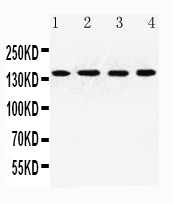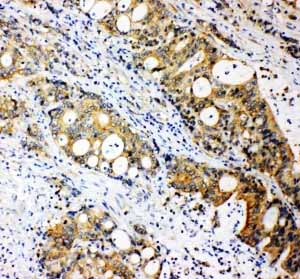Anti-INPPL1 Antibody
- SPECIFICATION
- CITATIONS
- PROTOCOLS
- BACKGROUND

Application
| WB, IHC-P |
|---|---|
| Primary Accession | O15357 |
| Host | Rabbit |
| Reactivity | Human, Mouse, Rat |
| Clonality | Polyclonal |
| Format | Lyophilized |
| Description | Rabbit IgG polyclonal antibody for Phosphatidylinositol 3,4,5-trisphosphate 5-phosphatase 2(INPPL1) detection. Tested with WB, IHC-P in Human;Mouse;Rat. |
| Reconstitution | Add 0.2ml of distilled water will yield a concentration of 500ug/ml. |
| Gene ID | 3636 |
|---|---|
| Other Names | Phosphatidylinositol 3, 4, 5-trisphosphate 5-phosphatase 2, 3.1.3.86, Inositol polyphosphate phosphatase-like protein 1, INPPL-1, Protein 51C, SH2 domain-containing inositol 5'-phosphatase 2, SH2 domain-containing inositol phosphatase 2, SHIP-2, INPPL1, SHIP2 |
| Calculated MW | 138599 MW KDa |
| Application Details | Immunohistochemistry(Paraffin-embedded Section), 0.5-1 µg/ml, Human, Mouse, Rat, By Heat Western blot, 0.1-0.5 µg/ml, Human, Rat, Mouse |
| Subcellular Localization | Cytoplasm, cytosol. Cytoplasm, cytoskeleton. Membrane; Peripheral membrane protein. Cell projection, filopodium. Cell projection, lamellipodium. Translocates to membrane ruffles when activated, translocation is probably due to different mechanisms depending on the stimulus and cell type. Partly translocated via its SH2 domain which mediates interaction with tyrosine phosphorylated receptors such as the FC-gamma-RIIB receptor (FCGR2B). Tyrosine phosphorylation may also participate in membrane localization. Insulin specifically stimulates its redistribution from the cytosol to the plasma membrane. Recruited to the membrane following M-CSF stimulation. In activated spreading platelets, localizes with actin at filopodia, lamellipodia and the central actin ring. |
| Tissue Specificity | Widely expressed, most prominently in skeletal muscle, heart and brain. Present in platelets. Expressed in transformed myeloid cells and in primary macrophages, but not in peripheral blood monocytes. . |
| Protein Name | Phosphatidylinositol 3,4,5-trisphosphate 5-phosphatase 2 |
| Contents | Each vial contains 5mg BSA, 0.9mg NaCl, 0.2mg Na2HPO4, 0.05mg Thimerosal, 0.05mg NaN3. |
| Immunogen | A synthetic peptide corresponding to a sequence in the middle region of human INPPL1(349-363aa QRDSQEDWTTFTHDR), identical to the related rat and mouse sequences. |
| Purification | Immunogen affinity purified. |
| Cross Reactivity | No cross reactivity with other proteins |
| Storage | At -20˚C for one year. After r˚Constitution, at 4˚C for one month. It˚Can also be aliquotted and stored frozen at -20˚C for a longer time.Avoid repeated freezing and thawing. |
| Sequence Similarities | Belongs to the inositol 1,4,5-trisphosphate 5- phosphatase family. |
| Name | INPPL1 (HGNC:6080) |
|---|---|
| Function | Phosphatidylinositol (PtdIns) phosphatase that specifically hydrolyzes the 5-phosphate of phosphatidylinositol-3,4,5-trisphosphate (PtdIns(3,4,5)P3) to produce PtdIns(3,4)P2, thereby negatively regulating the PI3K (phosphoinositide 3-kinase) pathways (PubMed:16824732). Required for correct mitotic spindle orientation and therefore progression of mitosis (By similarity). Plays a central role in regulation of PI3K-dependent insulin signaling, although the precise molecular mechanisms and signaling pathways remain unclear (PubMed:9660833). While overexpression reduces both insulin-stimulated MAP kinase and Akt activation, its absence does not affect insulin signaling or GLUT4 trafficking (By similarity). Confers resistance to dietary obesity (By similarity). May act by regulating AKT2, but not AKT1, phosphorylation at the plasma membrane (By similarity). Part of a signaling pathway that regulates actin cytoskeleton remodeling (PubMed:11739414, PubMed:12676785). Required for the maintenance and dynamic remodeling of actin structures as well as in endocytosis, having a major impact on ligand-induced EGFR internalization and degradation (PubMed:15668240). Participates in regulation of cortical and submembraneous actin by hydrolyzing PtdIns(3,4,5)P3 thereby regulating membrane ruffling (PubMed:21624956). Regulates cell adhesion and cell spreading (PubMed:12235291). Required for HGF-mediated lamellipodium formation, cell scattering and spreading (PubMed:15735664). Acts as a negative regulator of EPHA2 receptor endocytosis by inhibiting via PI3K-dependent Rac1 activation (PubMed:17135240). Acts as a regulator of neuritogenesis by regulating PtdIns(3,4,5)P3 level and is required to form an initial protrusive pattern, and later, maintain proper neurite outgrowth (By similarity). Acts as a negative regulator of the FC-gamma-RIIA receptor (FCGR2A) (PubMed:12690104). Mediates signaling from the FC-gamma-RIIB receptor (FCGR2B), playing a central role in terminating signal transduction from activating immune/hematopoietic cell receptor systems (PubMed:11016922). Involved in EGF signaling pathway (PubMed:11349134). Upon stimulation by EGF, it is recruited by EGFR and dephosphorylates PtdIns(3,4,5)P3 (PubMed:11349134). Plays a negative role in regulating the PI3K-PKB pathway, possibly by inhibiting PKB activity (PubMed:11349134). Down-regulates Fc-gamma-R-mediated phagocytosis in macrophages independently of INPP5D/SHIP1 (By similarity). In macrophages, down-regulates NF-kappa-B-dependent gene transcription by regulating macrophage colony-stimulating factor (M-CSF)-induced signaling (By similarity). Plays a role in the localization of AURKA and NEDD9/HEF1 to the basolateral membrane at interphase in polarized cysts, thereby mediates cell cycle homeostasis, cell polarization and cilia assembly (By similarity). Additionally promotion of cilia growth is also facilitated by hydrolysis of (PtdIns(3,4,5)P3) to PtdIns(3,4)P2 (By similarity). Promotes formation of apical membrane-initiation sites during the initial stages of lumen formation via Rho family-induced actin filament organization and CTNNB1 localization to cell-cell contacts (By similarity). May also hydrolyze PtdIns(1,3,4,5)P4, and could thus affect the levels of the higher inositol polyphosphates like InsP6. Involved in endochondral ossification (PubMed:23273569). |
| Cellular Location | Cytoplasm, cytosol. Cytoplasm, cytoskeleton. Membrane; Peripheral membrane protein. Cell projection, filopodium. Cell projection, lamellipodium. Basal cell membrane {ECO:0000250|UniProtKB:F1PNY0}. Nucleus {ECO:0000250|UniProtKB:D7PF45} Nucleus speckle {ECO:0000250|UniProtKB:D7PF45}. Cytoplasm, cytoskeleton, spindle pole {ECO:0000250|UniProtKB:F1PNY0} Note=Translocates to membrane ruffles when activated, translocation is probably due to different mechanisms depending on the stimulus and cell type (PubMed:11739414). Partly translocated via its SH2 domain which mediates interaction with tyrosine phosphorylated receptors such as the FC-gamma-RIIB receptor (FCGR2B). Tyrosine phosphorylation may also participate in membrane localization. Insulin specifically stimulates its redistribution from the cytosol to the plasma membrane. Recruited to the membrane following M-CSF stimulation. In activated spreading platelets, localizes with actin at filopodia, lamellipodia and the central actin ring. |
| Tissue Location | Widely expressed, most prominently in skeletal muscle, heart and brain. Present in platelets. Expressed in transformed myeloid cells and in primary macrophages, but not in peripheral blood monocytes. |

Thousands of laboratories across the world have published research that depended on the performance of antibodies from Abcepta to advance their research. Check out links to articles that cite our products in major peer-reviewed journals, organized by research category.
info@abcepta.com, and receive a free "I Love Antibodies" mug.
Provided below are standard protocols that you may find useful for product applications.
Background
INPPL1(Inositol polyphosphate phosphatase-like 1), also called SHIP2, encodes inositol polyphosphate-5 phosphatase-like 1, a protein that in addition to the phosphatase domain contains an SH2(src-homology domain 2) motif. INPPL1 is a member of the family of inositol triphosphate phosphatases. The INPPL1 gene is mapped on 11q13.4. Immunoblot analysis revealed that SHIP2 was widely expressed in fibroblast and nonhematopoietic tumor cell lines, unlike the SHIP protein, which was found only in cell lines of hematopoietic origin. Using human epithelial cell lines and primary human corneal and epidermal keratinocytes, Yu et al.(2008) showed that microRNA-184(MIR184) interfered with the ability of MIR205 to downregulate expression of SHIP2.SHIP2 may play a significant role in regulation of phosphatidylinositol 3-prime-kinase signaling by growth factors and insulin. By targeting the translation-initiating ATG codon and deleting the first 18 exons encoding Inppl1, Sleeman et al.(2005) generated Inppl1 -/- mice that were null for Inppl1 mRNA and protein.
If you have used an Abcepta product and would like to share how it has performed, please click on the "Submit Review" button and provide the requested information. Our staff will examine and post your review and contact you if needed.
If you have any additional inquiries please email technical services at tech@abcepta.com.













 Foundational characteristics of cancer include proliferation, angiogenesis, migration, evasion of apoptosis, and cellular immortality. Find key markers for these cellular processes and antibodies to detect them.
Foundational characteristics of cancer include proliferation, angiogenesis, migration, evasion of apoptosis, and cellular immortality. Find key markers for these cellular processes and antibodies to detect them. The SUMOplot™ Analysis Program predicts and scores sumoylation sites in your protein. SUMOylation is a post-translational modification involved in various cellular processes, such as nuclear-cytosolic transport, transcriptional regulation, apoptosis, protein stability, response to stress, and progression through the cell cycle.
The SUMOplot™ Analysis Program predicts and scores sumoylation sites in your protein. SUMOylation is a post-translational modification involved in various cellular processes, such as nuclear-cytosolic transport, transcriptional regulation, apoptosis, protein stability, response to stress, and progression through the cell cycle. The Autophagy Receptor Motif Plotter predicts and scores autophagy receptor binding sites in your protein. Identifying proteins connected to this pathway is critical to understanding the role of autophagy in physiological as well as pathological processes such as development, differentiation, neurodegenerative diseases, stress, infection, and cancer.
The Autophagy Receptor Motif Plotter predicts and scores autophagy receptor binding sites in your protein. Identifying proteins connected to this pathway is critical to understanding the role of autophagy in physiological as well as pathological processes such as development, differentiation, neurodegenerative diseases, stress, infection, and cancer.



